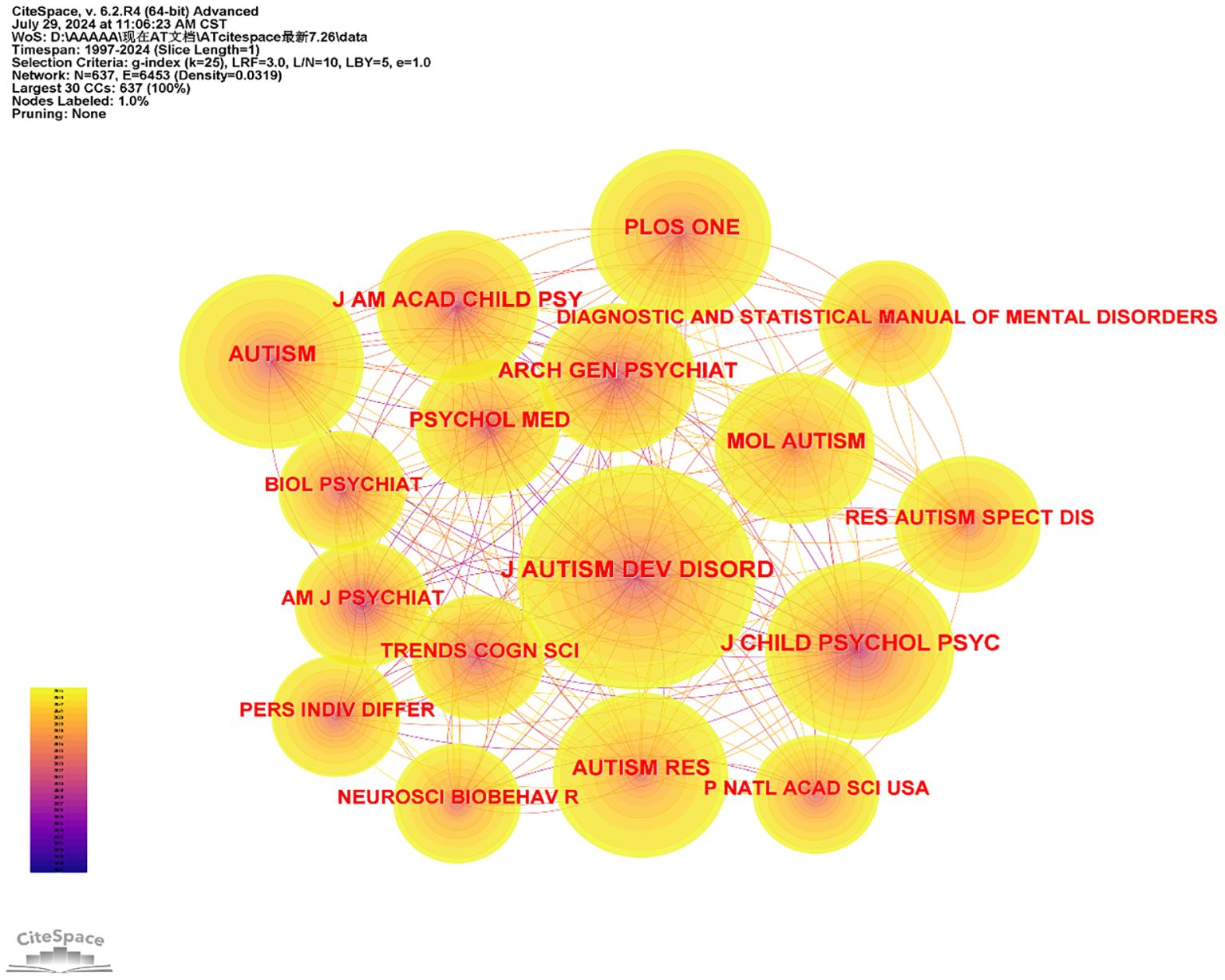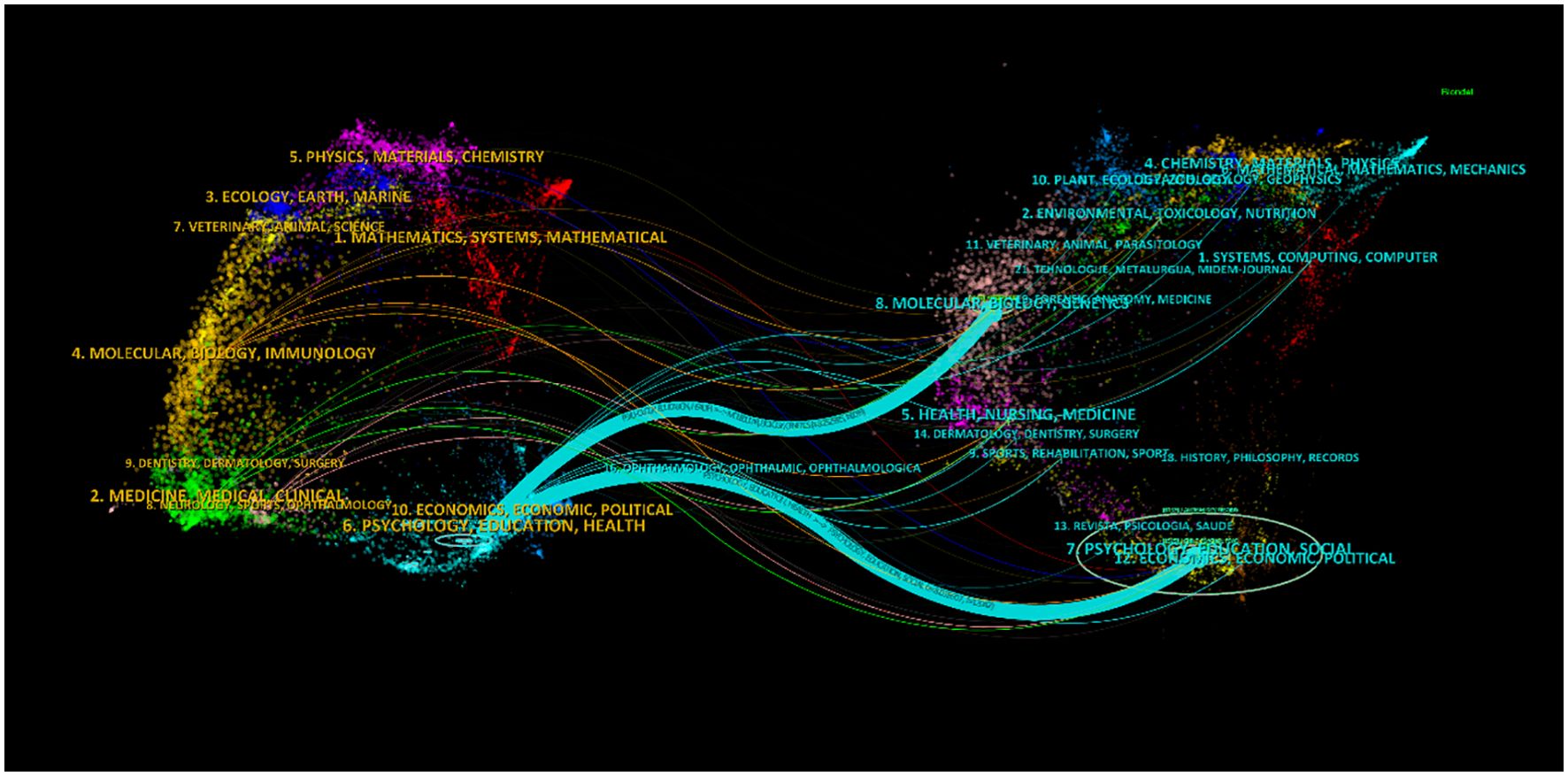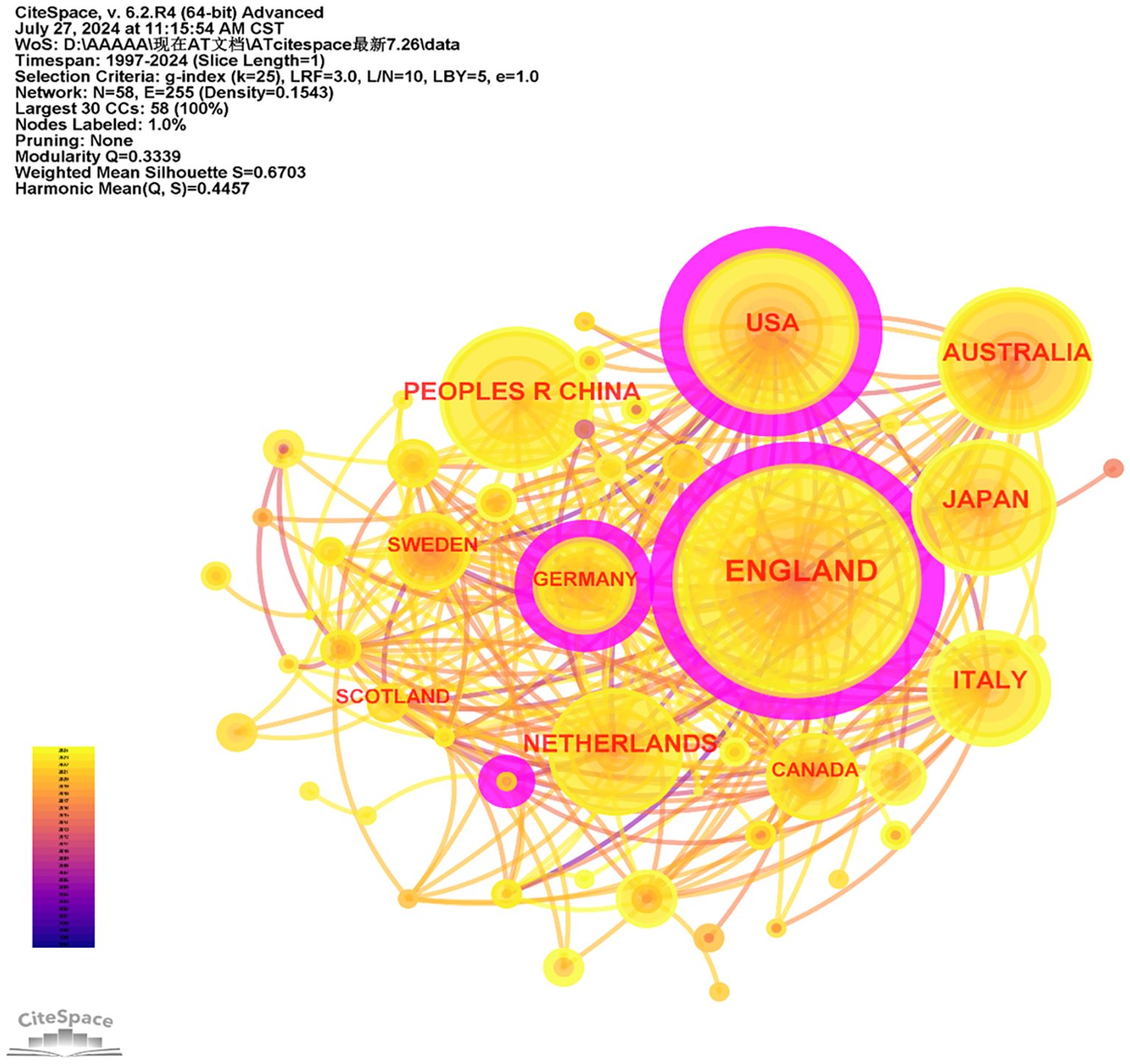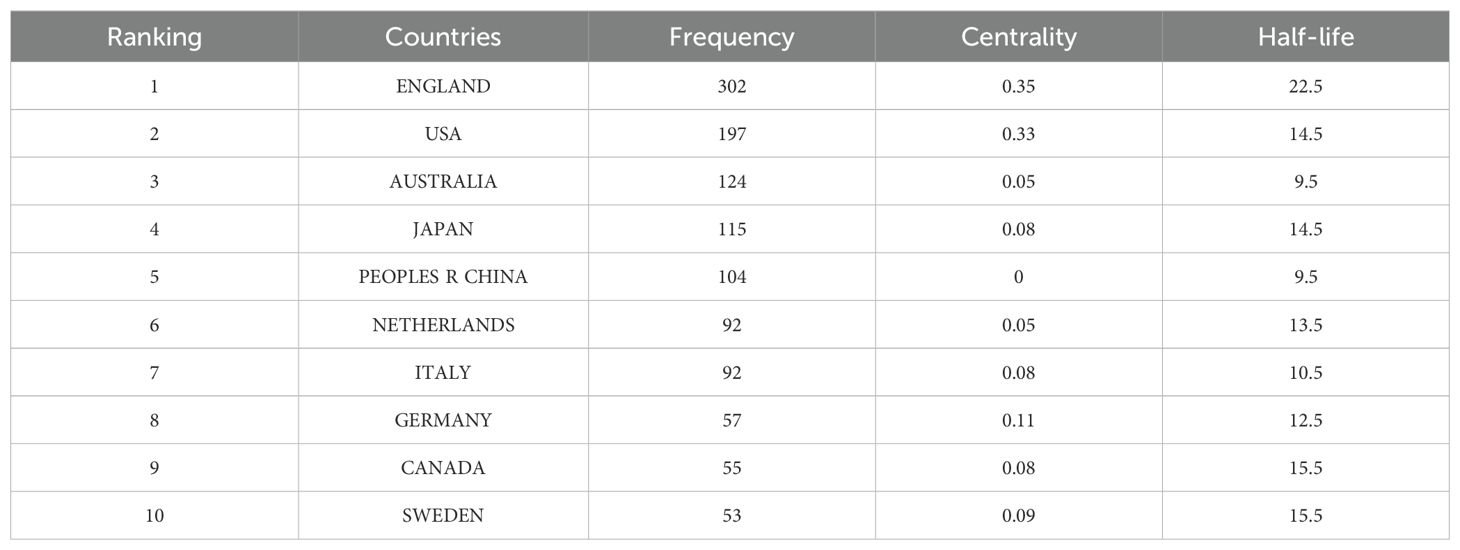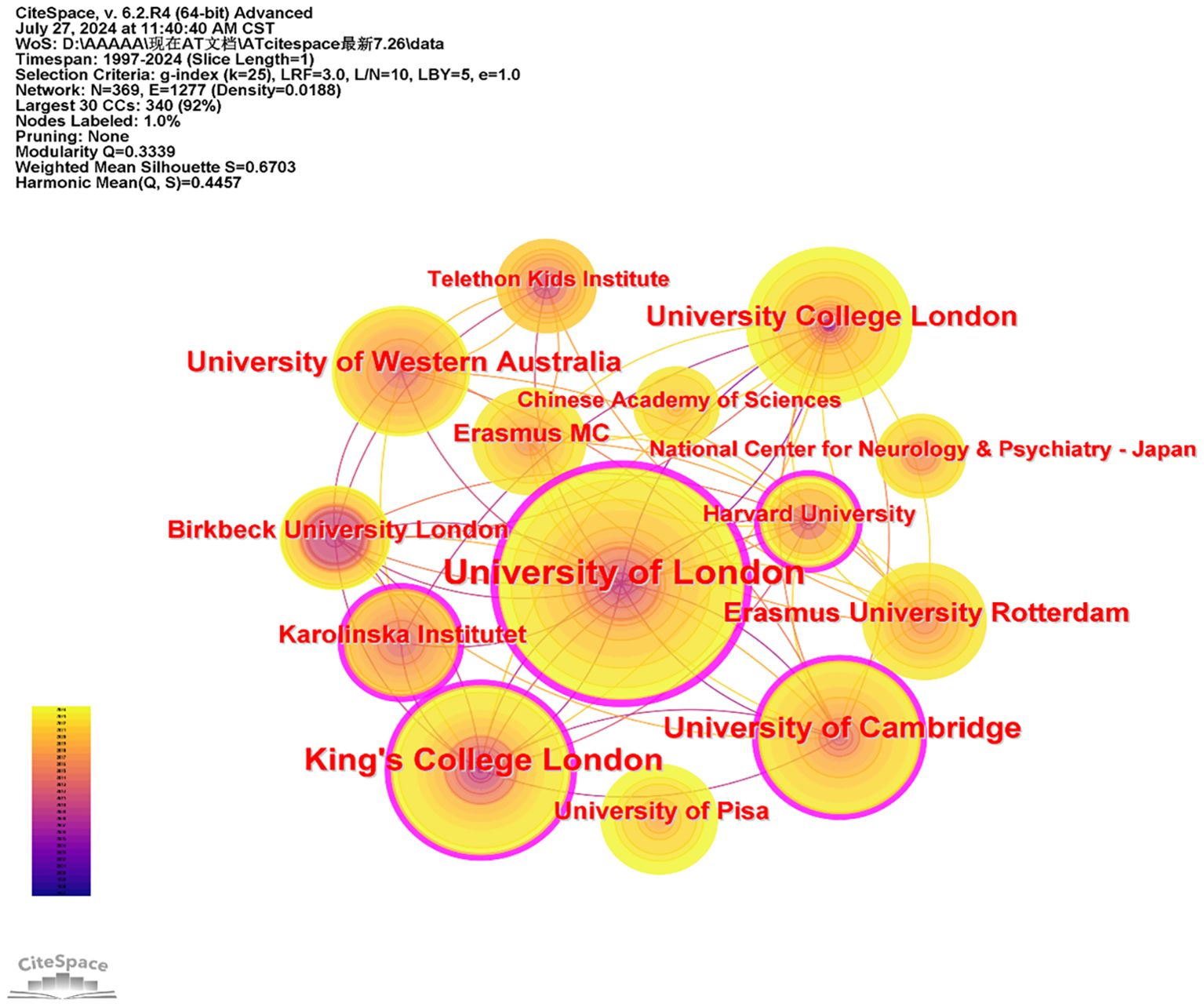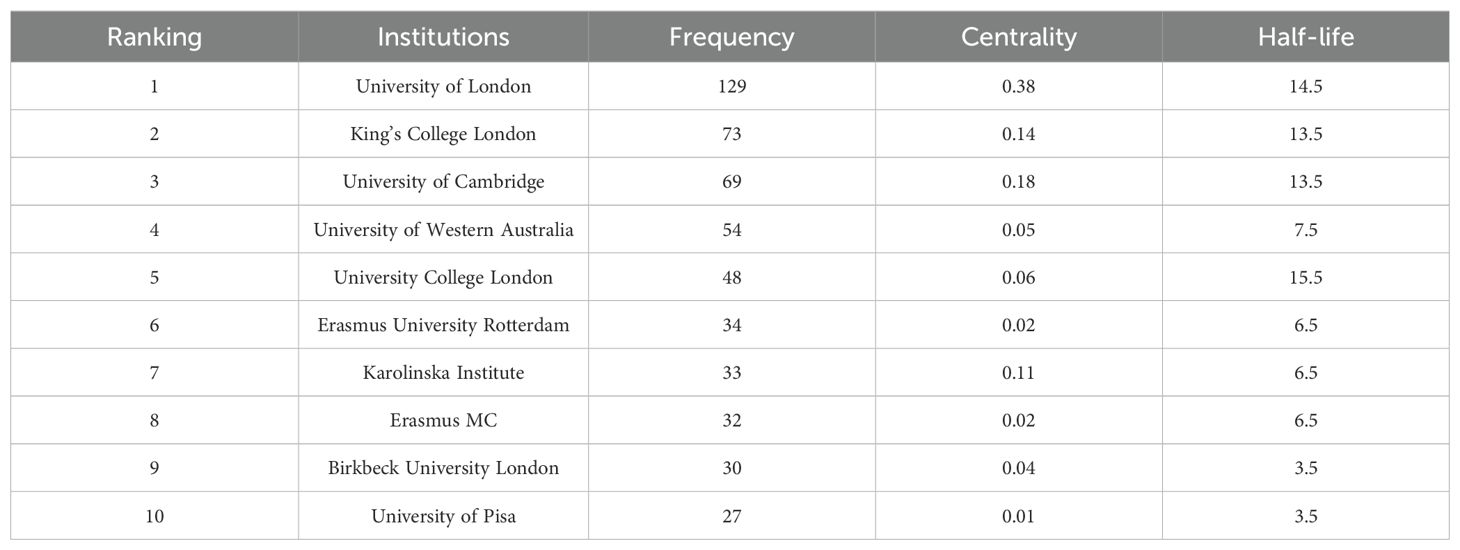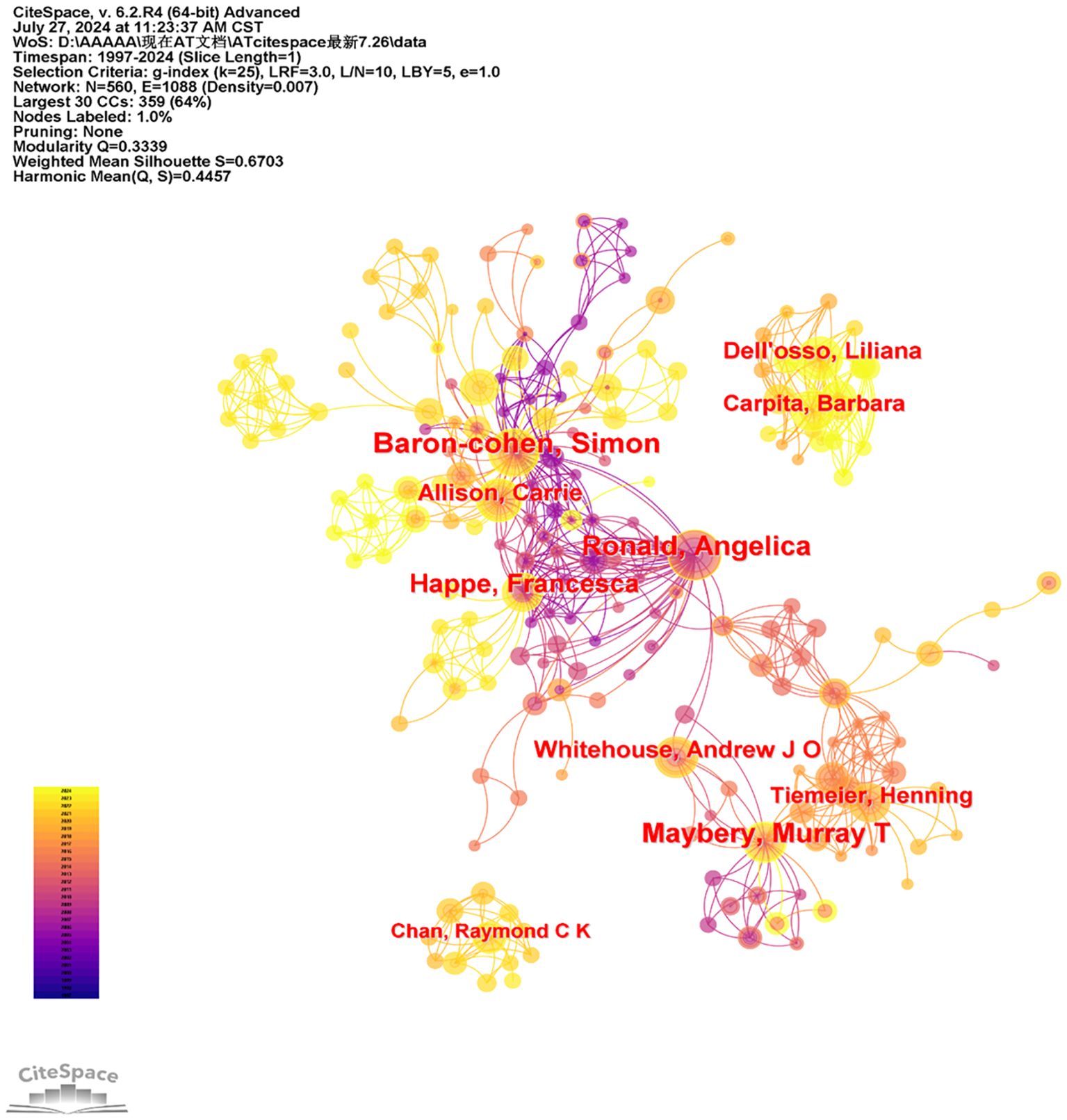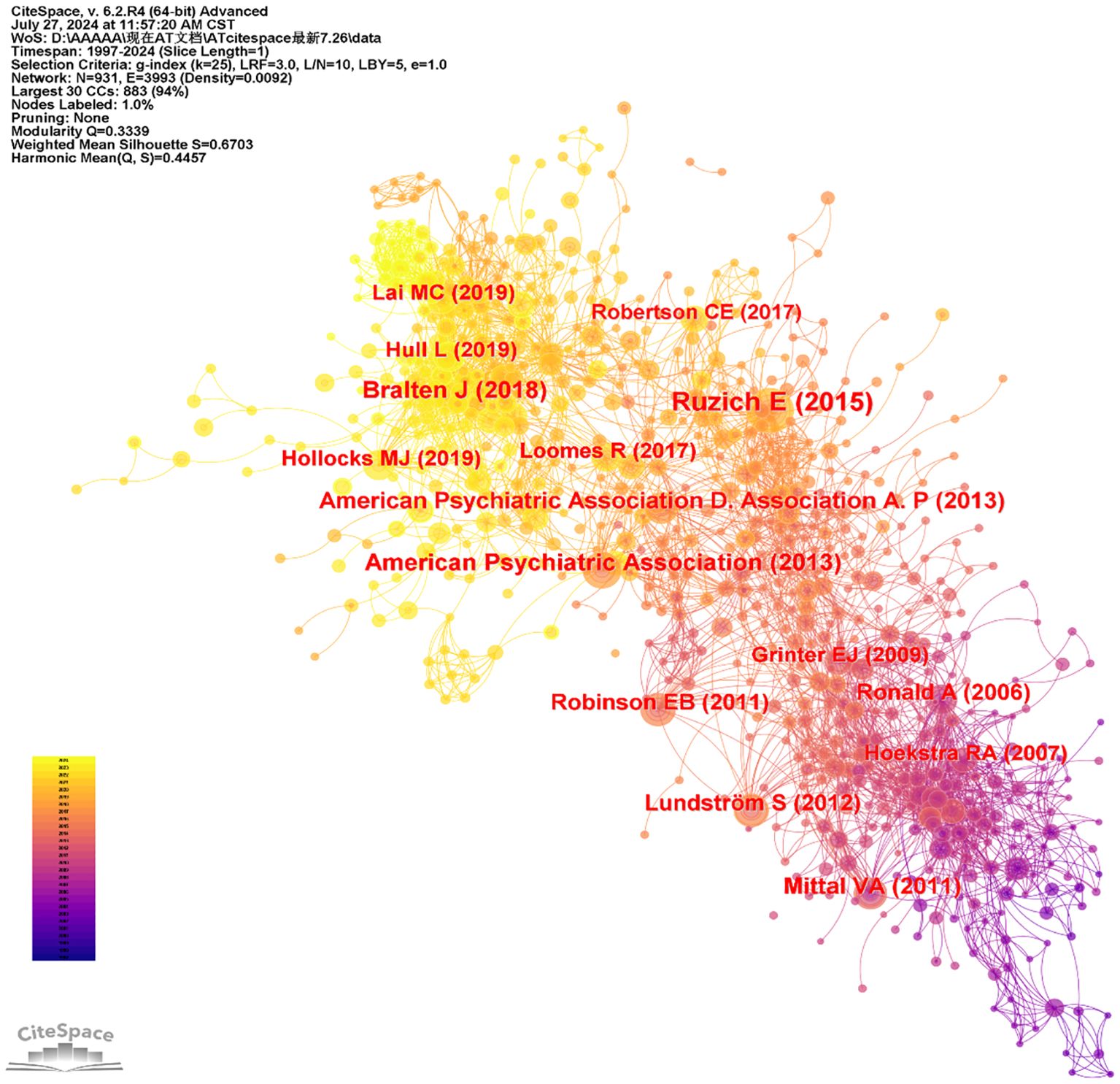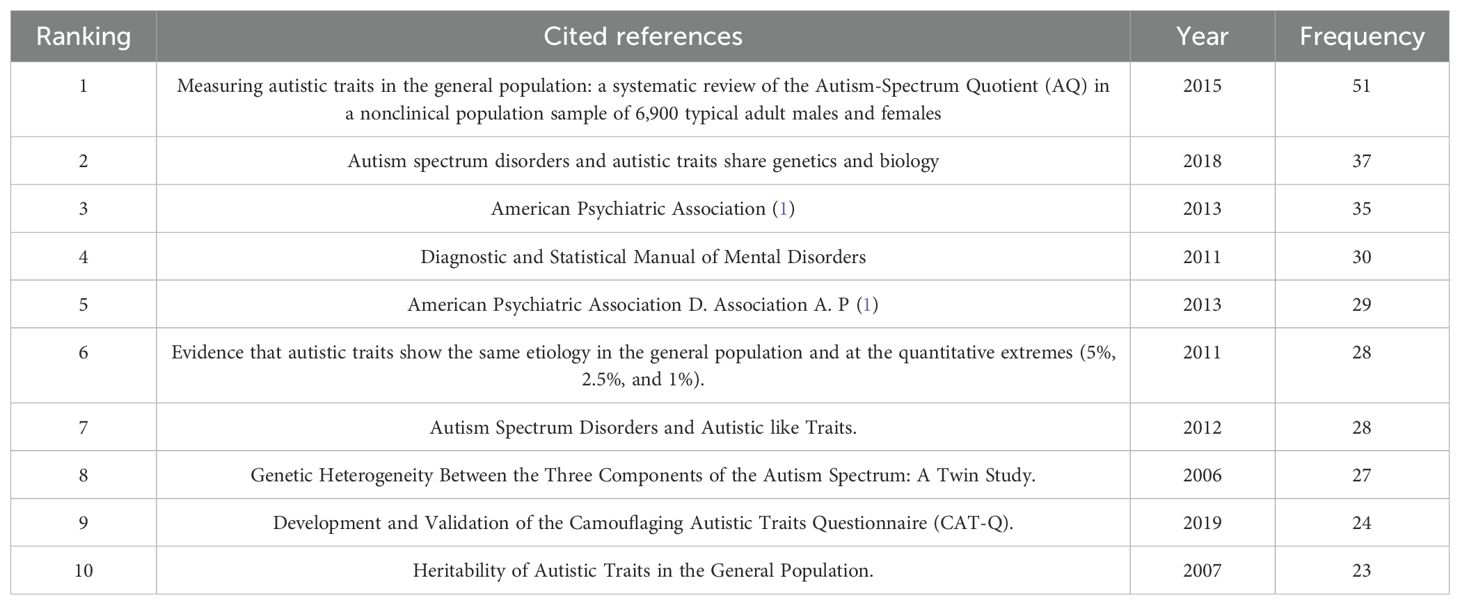- 1School of Education and Psychology, University of Jinan, Jinan, China
- 2Tianjin Yang Jialou Senior High School, Tianjin, China
- 3Department of Psychology, Ningbo University, Ningbo, Zhejiang, China
- 4Shandong Mental Health Center, Shandong University, Jinan, Shandong, China
Objective: The aim of this study was to analyze the research hotspots and frontiers in the field of autistic traits (AT) between 1997 and 2024.
Methods: The Web of Science Core Collection (WOSCC) is used as a data source in the study, analyzing 1,044 academic articles on AT published between 1997 and 2024. The included articles were visually analyzed using CiteSpace 6.2.R4 software, which is used to map keywords and core literature related to AT and to analyze research progress and emerging hotspots in the field
Results: A total of 1,044 articles have been included in the analysis, and the total number of articles has demonstrated an upward trajectory. The nations of England, the USA, and Australia are at the vanguard of this body of literature. With regard to research institutions, the University of London has attracted considerable attention as a result of its substantial contributions to the field of AT. The most relevant research is published in the Journal of Autism and Developmental Disorders.
Conclusion: The scope of AT research has expanded considerably, encompassing psychology, education, and other disciplines. The research dimensions extend beyond behavioral, genetic, cognitive, and neural aspects to include environmental and hormonal factors. Furthermore, the study population has evolved from twins and the general population to focus on specific groups, such as individuals with psychiatric disorders. This broadening of focus has led to a significant increase in AT research in recent years. In sum, this study provides a comprehensive perspective that can inform and guide further in-depth research on AT.
1 Introduction
Autistic traits (AT) are characteristics that resemble, though are less pronounced than, the behavioral manifestations and personality traits observed in individuals with autism. These traits encompass a range of social interactions and social-emotional competencies, including indifference, unsophistication, subtlety, unresponsiveness, and a lack of emotional response and empathy. Autism spectrum disorder (ASD) is a neurodevelopmental condition characterized by persistent deficits in social communication and interaction across multiple contexts, along with repetitive and stereotyped behaviors, narrow interests, and restricted activities (1). Autistic traits are increasingly described as a collection of behavioral, personality, and cognitive characteristics associated with ASD (2). These traits are found in both individuals with ASD and the general population, though they differ quantitatively in severity (3). Those with high levels of AT and individuals with ASD share similarities in various emotional, cognitive, and behavioral domains, including elevated anxiety, impaired cognitive flexibility, and deficits in social skills (4–7).
The earliest research on AT dates back to a 1997 study, which provided a detailed characterization of learning disabilities, revealing that adults with such disabilities frequently exhibit these traits. Furthermore, the study indicated that younger individuals and those with severe or pervasive learning disabilities are more likely to manifest AT (8). Early research efforts exhibited a relatively narrow focus, primarily concentrating on twin samples, the general population, and individuals diagnosed with ASD (9, 10). Early research also focused on measuring AT, with a greater emphasis on the assessment tools themselves. Specifically, studies explored the use of instruments such as the Social Responsiveness Scale (SRS) and the Autism-Spectrum Quotient (AQ), including various iterations of the AQ, during the period of 2003-2006 (11–13).
In 2008, a seminal publication elucidated the “fractionable autism triad” through behavioral, genetic, cognitive, and neural evidence. This work provided a framework, encompassing these four dimensions. (14). Regarding behavioral dimensions, for instance, research might explore how AT predicts behavioral outcomes (15). In the realm of genetics, studies could examine associated genes (16). Furthermore, these dimensions can be integrated in research. For instance, studies have investigated the influence of genetics on behavior within the genetic and behavioral dimensions (17). Similarly, the cognitive and behavioral dimensions can be studied in conjunction (18).However, the research extends beyond these four dimensions, encompassing additional dimensions such as environmental and emotional factors. The extant literature on AT is expanding, with research increasingly focusing on specific populations. For example, research on cohorts with obsessive-compulsive disorder, anorexia nervosa, attention-deficit/hyperactivity disorder, bipolar affective disorder, and post-traumatic stress disorder commonly examines behavioral, genetic, cognitive, and neurological dimensions (19, 20).
Literature reviews, a vital component of educational and scientific research, play a crucial role in summarizing and synthesizing research findings (21, 22). Currently, a lack of bibliometric analysis on AT leave uncertainties regarding the focus of current research and the overall evolution in the field. This study utilizes CiteSpace to graphically examine various aspects of research on AT, including the annual number of publications, authors, institutions, countries, journals, cited references, and keywords. This study not only provides valuable guidance for future research and application but also offers a much-needed methodological framework for understanding the development of the field.
2 Methods
2.1 Data source
In the current study, several databases were adopted. Web of Science (WoS) is one of the most well-known scientific citation index databases in the world. Publications included in the Web of Science Core Collection (WoSCC) are considered an essential part of the research process. In 2020, the Web of Science Core Collection will contain more than 74.8 million scientific records and 1.5 billion references in 254 subject areas dating back to 1900 (23–25). Therefore, in this study, we chose the WoSCC database as our primary data source.
2.2 Search strategy (Figure 1)
All data were retrieved from WoSCC on July 25, 2024, using a four-component approach: (i) topic = autistic traits; (ii) document type = “article” or “review article”; (iii) language = English. The plain text format of complete records and their corresponding cited references were downloaded for further examination.
2.2.1 Inclusion criteria
Inclusion criteria were: (i) articles extracted from the WoSCC; (ii) articles or review articles; (iii) articles written in English; (iv) articles on AT.
2.2.2 Exclusion criteria
Exclusion criteria were as follows: (i) hand-collected articles; (ii) articles not formally published; (iii) conference abstracts and proceedings; (iv) duplicate publications or the same study; (v) articles unrelated to the topic; and (vi) articles not written in English.
2.3 Analysis tool
CiteSpace is a valuable and essential tool for analyzing scientific literature. It is primarily used to evaluate the corpus of papers within a specific field and to illustrate the structure and trajectory of research in that domain, facilitating the identification of patterns, hotspots, and the evolution of knowledge over time (26, 27). In this study, CiteSpace V.6.2.R4 (64-bit) was applied to analyze research related to AT. The goal was to provide evidence-based support for researchers, gain insights into the current state and trends within the field, and generate new ideas for future development.
2.4 Data analysis
CiteSpace is specifically designed to facilitate the detection of emerging trends and abrupt changes in the scientific literature (28). In this study, the CiteSpace software was used to identify citation bursts across multiple dimensions, such as research publication year, author, research institution, journal, country, keywords, and hotspots.
3 Results
3.1 Annual publication analysis
Using the specified search strategy, a total of 1,044 publications meeting the inclusion criteria were retrieved. Figure 2 illustrates the annual number of articles published on AT. The document types are divided into two categories: articles and reviews. As can be seen, the number of reviews is relatively small. The first qualifying article on AT was published in 1997. Between 1997 and 2012, the number of articles on AT remained relatively low, with fewer than 30 articles published per year. Starting in 2012, there was a gradual increase in the number of AT articles, with notable surges observed between 2019 and 2020, and again between 2022 and 2023. The total number of articles published from 1997 to 2019 is less than the number of articles published in the most recent five-year period. It should be noted that the count of AT articles for 2024 is limited due to data collection being conducted in July of that year. This trend indicates that research on AT is currently a prominent focus, with the majority of articles published in the past five years.
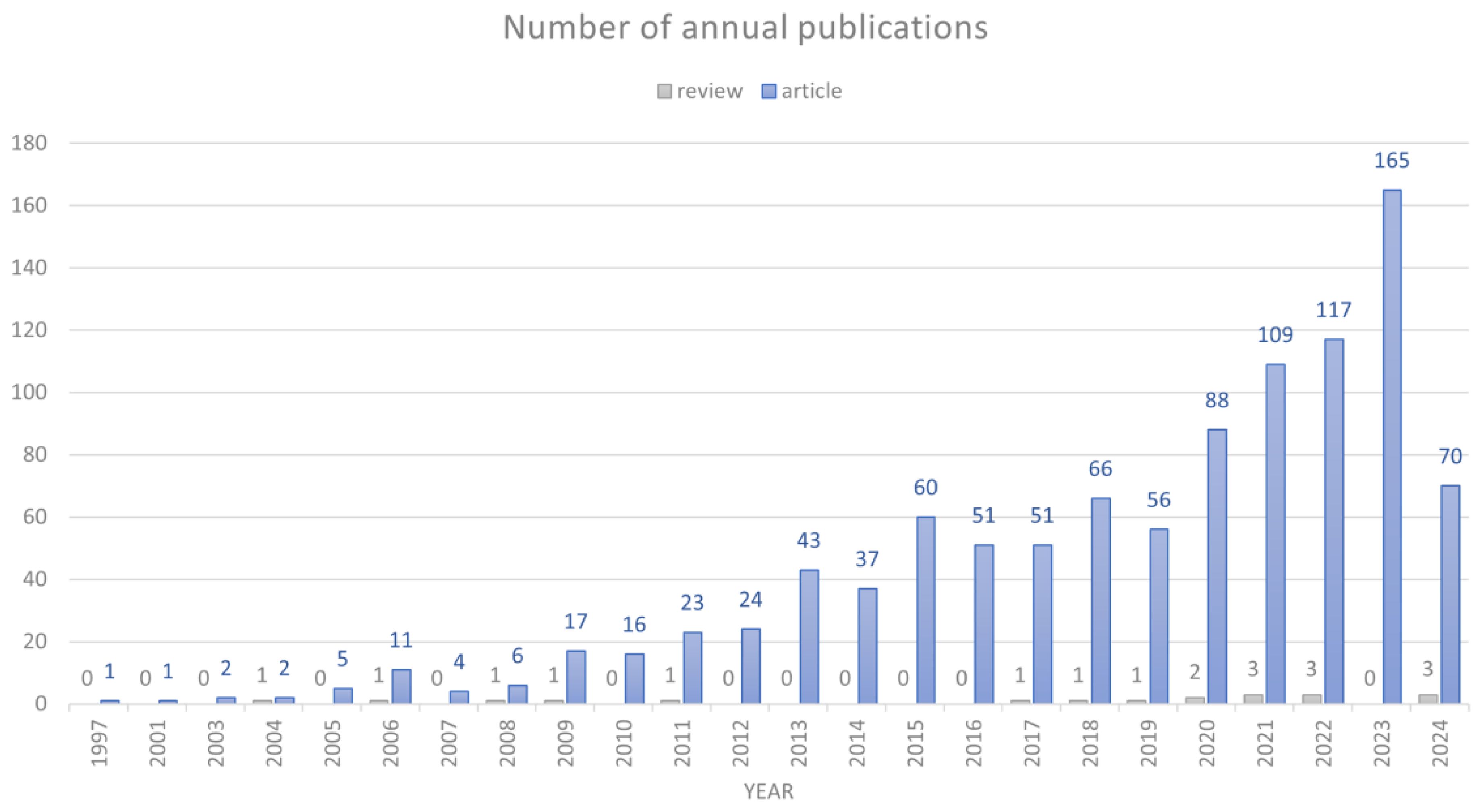
Figure 2. The number of annual publications and growth trends of Autistic Traits (AT) from 1997 to 2024.
3.2 Cited journals analysis
Analyzing the journals cited in the field of AT provides valuable insights into key sources of knowledge dissemination and facilitates the efficient location of relevant information. In this study, articles on AT published between 1997 and 2024 were analyzed at one-year intervals. The cited journals were categorized as nodes, resulting in a distribution map with a merged network comprising 637 nodes and 6,453 links, as illustrated in Figure 3. In this network, journals are represented as nodes and their interconnections are depicted as lines. Nodes with higher frequency are considered more influential and impactful in the development of the scientific field. The thickness of the lines between nodes reflects the strength of their relationships. Figure 4 presents a dual-map overlay of journals, showing the relationships between cited journals on the left and citing journals on the right. The majority of journals are focused on the field of psychology, while others cover topics such as education, health, and social issues. Table 1 lists the top ten most cited journals in this field. The Journal of Autism and Developmental Disorders ranks first with 976 publications, followed by the Journal of Child Psychology and Psychiatry with 604 publications, and Autism with 592 publications. PLOS ONE and Autism Research are the fourth and fifth most cited journals, respectively. It is noteworthy that most of the top ten journals by number of articles are from the United States.
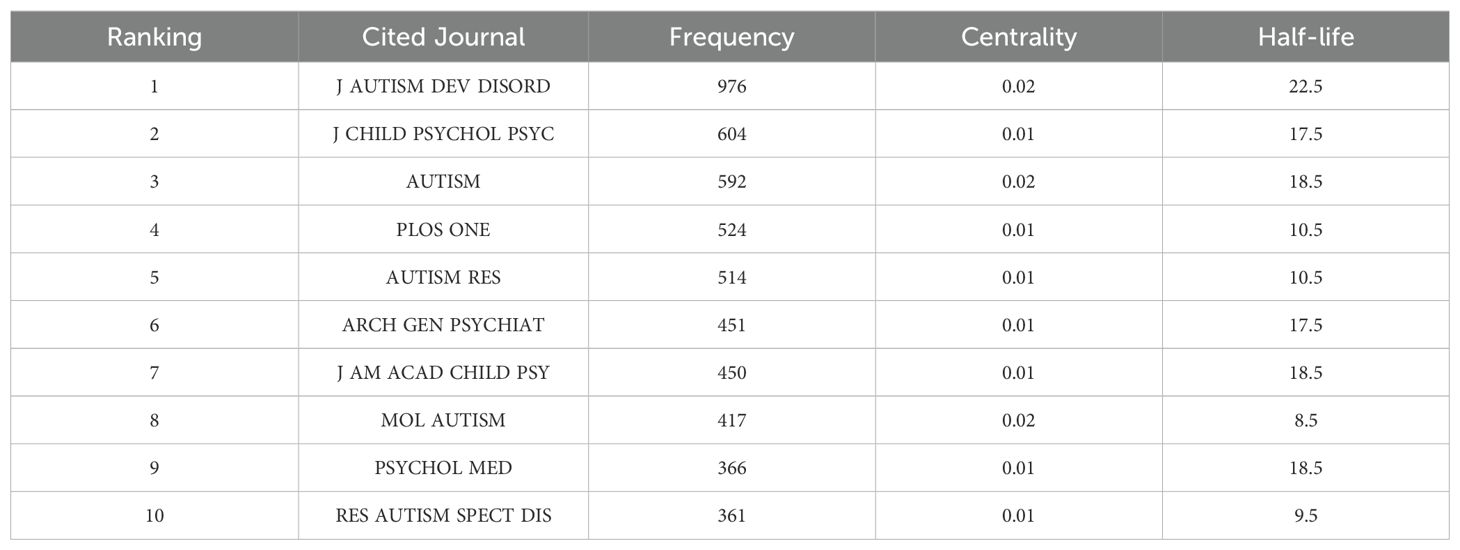
Table 1. The top ten cited journal and centrality in the research field of Autistic Traits (AT) from 1997 to 2024.
3.3 Countries analysis
To examine the connections between articles published in different countries, we analyzed all articles on AT from 1997 to 2024 at one-year intervals. This analysis produced a country-specific distribution map, shown in Figure 5, which displays a merged network consisting of 58 nodes and 255 links. In this network, nodes represent countries, and the lines illustrate the relationships between them. The size of the nodes reflects the number of publications, with larger nodes indicating higher publication productivity.
Table 2 lists the top ten most productive countries in AT research. England leads with the highest publication productivity, totaling 302 articles, followed by the USA with 197 articles. These are the only two countries with more than 150 articles. Australia, Japan, China, and the Netherlands follow.
3.4 Institutional analysis
CiteSpace was employed to generate a network map to explore collaborative relationships between institutions and to identify influential institutions in the field of AT. The node type was set to institution, resulting in a distribution map comprising 369 nodes and 1,277 links, as shown in Figure 6. In this map, nodes represent institutions, and lines depict the relationships between them. Institutions with a higher number of published papers are generally considered more important and influential.
Table 3 presents the top ten most productive institutions in this field. The University of London ranks first with 129 publications, followed by King’s College London with 73, and the University of Cambridge in third place with 69. Most of the top ten institutions are located in England, highlighting the country’s prominent role in the field. Additionally, the close connections between major institutions indicate strong collaborative networks.
3.5 Authors analysis
The articles selected for analysis spanned from 1997 to 2024. Authors were designated as the node type to create a network map of co-authorship, as illustrated in Figure 7. This merged network map comprises 560 nodes and 1,088 links. In the map, nodes represent authors, and lines indicate their collaborative relationships. The size of each node corresponds to the author’s publication output, with larger nodes reflecting a higher number of published articles.
Among the active authors, Simon Baron-Cohen from the Autism Research Centre at the University of Cambridge ranks first with 38 publications. Other notable authors include Ronald Angelica from the University of London, Murray T. Maybery from the University of Western Australia, Francesca Happe from King’s College London, and Carrie Allison from the University of Cambridge. Table 4 lists the top ten most productive authors in this field. Many of these authors are from the United Kingdom and are trained psychologists, reflecting a strong network of collaboration within this region.
3.6 Cited references analysis
Co-citation analysis is a method used to measure the relationships between articles based on their simultaneous citation by other articles, indicating a co-citation relationship (29). For analysis, references were designated as the node type in CiteSpace, with articles published between 1997 and 2024. This approach generated a co-citation network map, revealing a merged network of 931 nodes and 3,993 links, as shown in Figure 8. In this network, nodes represent co-cited references, and lines describe the relationships between these co-citations.
Table 5 presents the top ten most cited references in this study. The most cited literature is “Measuring Autistic Traits in the General Population: A Systematic Review of the Autism-Spectrum Quotient (AQ) in a Nonclinical Population Sample of 6,900 Typical Adult Males and Females” by Ruzich et al. (30). This is followed by “Autism Spectrum Disorders and Autistic Traits: Shared Genetics and Biology” by Bralten et al. (31) and the “Diagnostic and Statistical Manual of Mental Disorders” by the American Psychiatric Association (1). The majority of co-citations focus on the academic performance and diagnosis of AT.
3.7 Keywords analysis
Keywords are essential for understanding the core topics of a study. Analyzing keywords allows us to summarize research themes, identify hotspots, and explore research directions (32). For this analysis, articles published between 1997 and 2024 were selected with a one-year time slice, and keywords were used as the node type in CiteSpace. This generated a keyword co-occurrence map comprising 529 nodes and 4,432 links, as shown in Figures 9A, B. The most frequently occurring keywords in this study include “children” (389 occurrences), “autistic traits” (366), “spectrum quotient AQ” (240), “adults” (187), “spectrum disorders” (181), “autism spectrum disorder” (161), “spectrum disorder” (150), “functioning autism” (144), and “Asperger syndrome” (127). A timeline based on keyword interactions and relationships within the field is constructed to explore the evolutionary trajectory and characteristics of the research domain. Figure 10 displays the top 15 keywords with the strongest citation bursts. The blue line represents the time intervals, while the red line indicates the periods of significant keyword bursts. In AT research, earlier keywords include “pervasive developmental disorders”, “family history,” and “asperger syndrome”. More recent keywords include “autism-spectrum quotient”, “mental health”, “brain” and “emotion recognition”. Additionally, terms such as “autistic-like traits” and “general population” show significant impact.
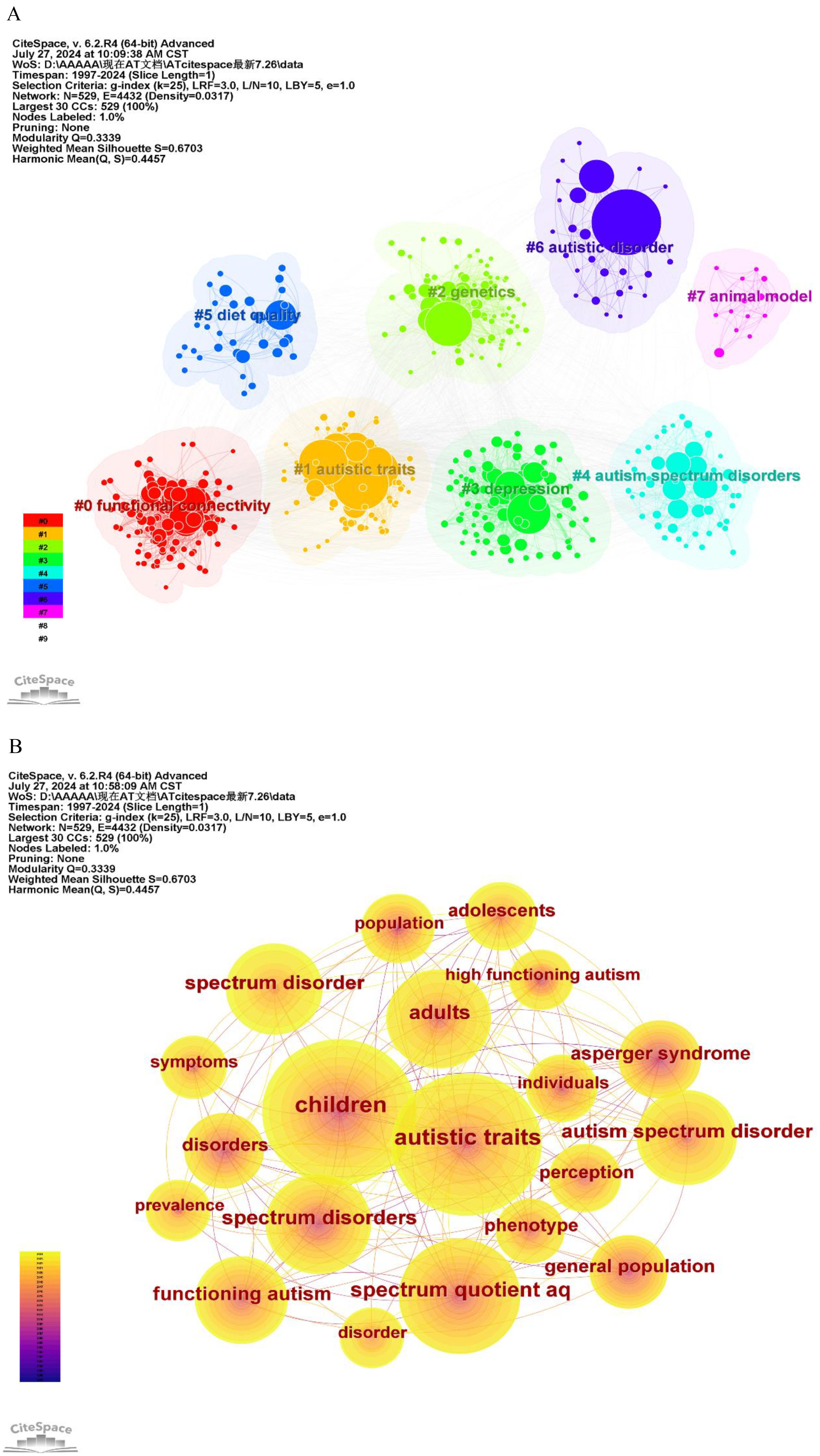
Figure 9. (A) The clustering map of keywords of AT from 1997 to 2024; and (B) The co-occurrence map of keywords of AT from 1997 to 2024.
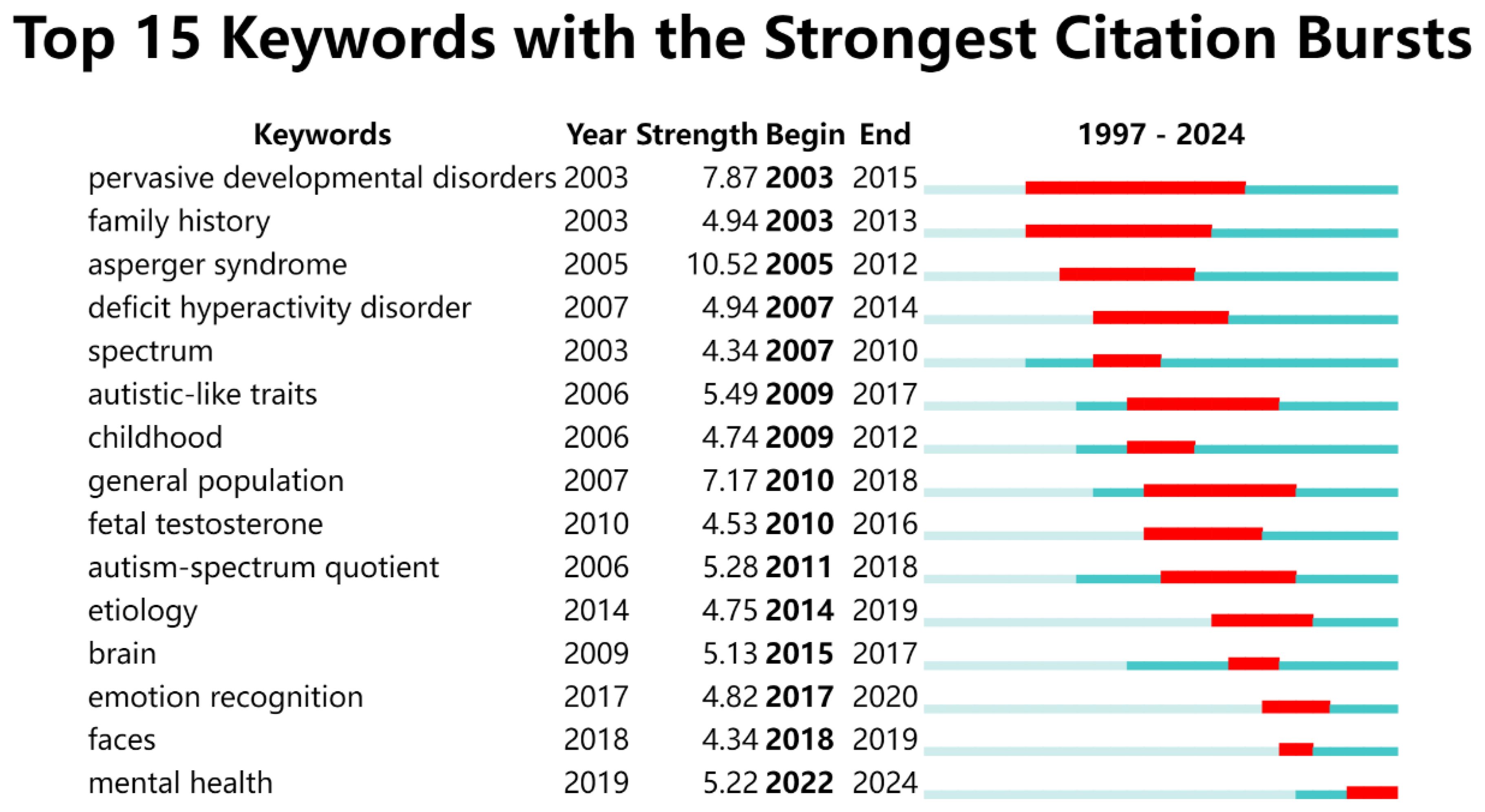
Figure 10. Visualization of top 15 keywords with the strongest citation bursts of AT from 1997 to 2024.
4 Discussion
4.1 Trends on AT
The analysis encompasses various aspects of the study of AT, including publications, journals, countries, institutions, authors, co-cited references, and keywords, as represented in CiteSpace. Notably, the seminal article on AT, “Autistic Traits in Adults with Learning Disabilities,” published in 1997, appears to have marked the beginning of this research area. This study explored the prevalence of AT and their association with maladaptive behaviors among adults with learning disabilities in a specific geographical region. It found that AT were prevalent in this population, and individuals with a higher number of these traits were more likely to be severely learning disabled and exhibit a wide range of challenging behaviors.
The growth trend in AT publications from 1997 to 2024 can be divided into two distinct phases. The first phase (1997 to 2012) is characterized by stagnation or slow emergence. The peak number of publications in this phase was 24, recorded in 2011 and 2012. The total number of publications during this phase was 117, indicating relatively modest growth. The second phase (2013 to 2024) represents a period of significant growth and rapid development. The data collection for 2024, which was conducted in July, indicates a preliminary count of 73 publications for that year. The total number of publications from 2013 to 2024 is 927, approximately nine times the number from the first phase. In particular, the number of articles published each year after 2020 shows a significant increase compared to the previous phase, with exceptional numbers in 2022 (120) and 2023 (165).
The presence of AT has been demonstrated not only in individuals diagnosed with ASD but also in the general population, where AT can be observed at subthreshold levels (33). Additionally, subsequent research has shown that other populations, including psychiatric patients with various disorders and participants in scientific courses, are also more likely to exhibit AT (3, 34–40). The combined presence of elevated schizotypal and autistic traits was associated with an even greater reduction in social functioning (41). Future research in the field of AT should continue to prioritize the study of specific populations, such as individuals with psychiatric disorders and those involved in criminal activities. This broadening of focus has led to a significant increase in AT research in recent years.
4.2 Research focus and hotspots on AT
4.2.1 Measuring tools for AT
The Social Responsiveness Scale (SRS) and the AQ have been widely recognized as valid instruments for assessing clinically significant AT. The SRS, formerly known as the Social Reciprocity Scale, gathers “first-hand” ratings from individuals (parents or teachers) who have observed the child in naturalistic social settings (12). The AQ was developed to measure the extent to which an adult of normal intelligence exhibits autistic traits (13). AQ has been widely adopted in the literature, with the term “spectrum quotient aq” appearing 240 times, ranking third in keyword frequency (see Figure 9B). A quantitative analysis of citations reveals a focus related to AT. The most cited study in this field is “Measuring Autistic Traits in the General Population: A Systematic Review of the Autism-Spectrum Quotient (AQ) in a Nonclinical Population Sample of 6,900 Typical Adult Males and Females” by Ruzich et al. (30), which has garnered 51 citations. This study underscores the significance of the Autism-Spectrum Quotient (AQ) in assessing AT.
The AQ has been administered to adults with autism who are of at least average intelligence, as well as to non-clinical controls and clinical control groups, including individuals with schizophrenia, prosopagnosia, anorexia, and depression. It is widely referenced across various disciplines, remaining a valuable tool for assessing AT in individuals with typical cognitive abilities (30). Researchers often assess the validity of these tools when conducting cross-cultural studies (42). Furthermore, alternative assessment instruments, such as the SCDC (the Social and Communication Disorders Checklist), are also employed (43), and the development of more effective measurement tools is encouraged.
4.2.2 Subthreshold autistic traits
AT are continuously distributed and exhibit moderate to high heritability (9, 12, 44), and AT are present in both individuals diagnosed with ASD and the general population, albeit at subthreshold levels (33). Jian and Xudong (45) noted that AT can be classified as suprathreshold or subthreshold (autistic-like traits), depending on whether symptom severity meets clinical diagnostic criteria. The initial investigation of first-degree relatives of individuals with ASD aimed to identify subthreshold autistic traits, also referred to as the “broad autism phenotype” (BAP) (46, 47). Many typical relatives of individuals with ASD exhibit behaviors similar to those with ASD but do not meet the criteria for a clinical diagnosis. These mild social and communicative impairments, along with personality and cognitive traits resembling those seen in ASD, are collectively referred to as the broad autism phenotype (48–50).
The continuum of subthreshold autistic traits includes both the BAP and traits found within the broader non-clinical population. However, the BAP, particularly in relatives of individuals with ASD, is commonly used in genetic studies and is associated with higher levels of subthreshold traits than the general population (51). Researchers used the Autism Spectrum Quotient (AQ) to assess the prevalence of BAP, aiming to determine whether parents of autistic children differ from parents of typically developing children (TDC) in their AQ scores. The findings support the hypothesis that social and communication impairments in parents of children with ASD are indicators of BAP (52). For example, children whose parents have subthreshold autistic traits show a significant shift toward more pathological scores in reciprocal social behavior. The continuous distribution of heritable subthreshold autism impairments is observed in both adults and children (53).
4.2.3 Social functioning
In previous studies, AT are distributed continuously along a spectrum, ranging from non-clinical to clinical conditions (33). Although AT are less severe than those observed in individuals with autism in some cases (54–57), they are no denying closely associated with difficulties in social functioning, particularly in the formation and maintenance of interpersonal relationships, which can negatively impact an individual’s quality of life (58).
The research has concentrated on the behavioral and mental health consequences for individuals with AT. It is evident that AT can hinder fulfilling social interactions. Individuals with higher levels of AT are more prone to experiences of bullying, despair, anxiety, and loneliness (5, 59, 60). Wing (61) examined the relationship between AT and challenging behaviors, using a five-question framework that assessed lack of speech, social interaction, empathy, stereotypies, and routines. Although Wing’s study provided valuable insights into specific behavioral manifestations of AT, it did not address genetic etiology, brain function, or mental health. Chaplin et al. (62) found that individuals with elevated AT, compared to neurotypical prisoners, are more likely to report suicidal ideation, self-harm, and vulnerability to mental illnesses. Additional evidence links sleep problems and poor mental health with AT. For instance, Stewart et al. (63) reported that older adults with high AT experience less restful sleep and more mental health impairments than those with low AT. Similarly, Liisa Salmela et al. (64) found that individuals with high AT report shorter sleep durations at age of 16.
Research in AT primarily focuses on an individual’s social functioning, investigating the correlation between AT levels and factors such as sleep and depression. However, intervention-based studies in this area are limited, potentially due to the high costs involved. Future research should explore intervention strategies and measures to improve the psychological well-being and sleep quality of individuals with high AT levels, thereby enhancing the practical significance of AT, which is encouraged. Notably, in the realm of behavioral prediction, one study utilized effective transfer learning algorithms to predict autism spectrum disorder (ASD), suggesting that AI algorithms can be employed in research alongside traditional experimental methods (65).
4.2.4 Geographical variations
We analyzed four countries (the UK, USA, Japan, and China) with significant contributions to autistic traits (AT) research. UK studies focus on gene-environment interactions, including twin studies, prenatal testosterone influences, and associations between autism and schizophrenia spectrum disorders (66, 67). Social cognition themes such as theory of mind, empathy deficits, and clinical vs. non-clinical group differences are also emphasized (68–70). US research spans broader environmental factors (e.g., prenatal pollution, chemical exposures), genetic explorations (e.g., SHANK3 mutations), neuroimaging techniques (fMRI, DTI), and comorbidity with conditions like ADHD and anxiety (71, 72). US studies also prioritize cross-cultural comparisons and large-scale epidemiological investigations, such as multinational cohort analyses (Fumiyo 73).
Japanese research frequently addresses sensory-perceptual processing, including cross-modal integration (visual-gustatory associations), temporal perception, and auditory processing (74, 75). Mental health topics, such as postpartum depression, occupational stress in pharmacists, and culturally specific phenomena like hikikomori (social withdrawal), are prominent (76). Additionally, Japanese studies focus on subclinical populations and non-clinical samples to examine AT manifestations in daily life (74, 77). Chinese investigations emphasize neurobiological mechanisms, such as gene variations (OXTR, IL-6), brain structural differences (gray/white matter connectivity), and oxytocin’s role (78–80). Social behaviors like camouflaging, emotional prosody recognition, and environmental factors (e.g., prenatal education, screen time) are also explored (81, 82). Gender differences in autism, particularly between females and males, constitute a key theme (83).
In methodological approaches, Chinese and Japanese studies predominantly employ behavioral experiments and localized assessment tools, prioritizing real-life interpersonal scenarios (84). In contrast, the UK and US utilize advanced neuroimaging and molecular techniques to investigate neural mechanisms and compile large-scale datasets (85, 86). East Asian research emphasizes AT’s impact on social functioning, advocating adaptive strategies like camouflaging (73), while Western studies focus on neurobiological foundations and therapeutic interventions (e.g., oxytocin administration, gene therapies) (87, 88). Collectively, these nations aim to elucidate genetic, neural, behavioral, and environmental mechanisms underlying AT and develop targeted intervention strategies.
5 Conclusion
This bibliometric review of the literature on AT over the past 20 years has provided a wealth of insight into the development of the field, global research hotspots, and progress. The analysis of 1,044 publications reveals a gradual increase in global research interest, with a significant expansion in the number of publications from just 1 in 1997 to 165 in 2023, highlighting the growing prominence of the field. The field’s growth accelerated markedly after 2019, with a notable increase from 57 in 2019 to 90 in 2020. The most rapid growth occurred between 2022 and 2023, when the number of publications increased from 120 to 165.
The primary research areas are psychology, education, social sciences, and health. The UK stands out as a major contributor, with extensive international, institutional, and individual collaborations driving the research forward. Initially focused on families with ASD, research now includes the general population, examining both suprathreshold and subthreshold autistic traits. Recent studies are exploring AT from genetic, brain function, and etiological perspectives, establishing a solid scientific foundation. The AQ remains a key tool in assessing AT, with ongoing efforts to refine its reliability and validity.
The existing literature on AT is extensive, reflecting its status as a current research hotspot. This prominence stems from the increasing specificity of research subjects and the breadth of research dimensions, encompassing cognitive and genetic aspects, each with numerous research questions. Current studies also demonstrate preliminary explorations of the boundaries of AT, such as its association with somatic symptom disorder (89). Investigating these relationships is a key focus in 2024, primarily at a theoretical level. A more extended research focus may build upon these theoretical foundations to develop practical and effective intervention strategies for specific populations, an area with limited existing literature.
This study offers a comprehensive and reliable overview of AT research, capturing its historical development and current trends. While it does not encompass all publications, it provides a representative sample that is invaluable for understanding the field’s challenges and opportunities. The findings highlight significant issues related to AQ, subthreshold autistic traits, and social functioning, and are likely to stimulate further in-depth research in these areas.
Author contributions
FQ: Conceptualization, Data curation, Formal analysis, Funding acquisition, Investigation, Methodology, Project administration, Resources, Software, Supervision, Validation, Visualization, Writing – original draft, Writing – review & editing. TD: Data curation, Formal analysis, Methodology, Software, Visualization, Writing – original draft, Writing – review & editing. YG: Visualization, Writing – review & editing, Methodology, Supervision, Validation. YD: Formal analysis, Investigation, Resources, Writing – review & editing. SL: Funding acquisition, Project administration, Supervision, Writing – review & editing. XQ: Funding acquisition, Methodology, Resources, Supervision, Writing – review & editing. DW: Investigation, Methodology, Resources, Supervision, Visualization, Writing – review & editing.
Funding
The author(s) declare that financial support was received for the research and/or publication of this article. This study was supported by Shandong Provincial Social Science Foundation Youth Program: “Study on the Supply-Demand Mismatch of Long-Term Care Services for Elderly with Dementia in Shandong Province and Exploration of Resolution Strategies” (23DSHJ05).
Conflict of interest
The authors declare that the research was conducted in the absence of any commercial or financial relationships that could be construed as a potential conflict of interest.
Generative AI statement
The author(s) declare that Generative AI was used in the creation of this manuscript.
In this study, generative ai is used to embellish statements, making them more fluent.
Publisher’s note
All claims expressed in this article are solely those of the authors and do not necessarily represent those of their affiliated organizations, or those of the publisher, the editors and the reviewers. Any product that may be evaluated in this article, or claim that may be made by its manufacturer, is not guaranteed or endorsed by the publisher.
References
1. American Psychiatric Association. Diagnostic and Statistical Manual of Mental Disorders (5th ed). Arlington, VA: American Psychiatric Publishing (2013). doi: 10.1176/appi.books.9780890425596.
2. Sucksmith E, Roth I, Hoekstra RA. Autistic traits below the clinical threshold: re-examining the broader autism phenotype in the 21st century. Neuropsychol Rev. (2011) 21:360–89. doi: 10.1007/s11065-011-9183-9
3. Baron-Cohen S, Wheelwright S, Skinner R, Martin J, Clubley E. The autism-spectrum quotient (AQ): evidence from Asperger syndrome/high-functioning autism, males and females, scientists and mathematicians. J Autism Dev Disord. (2001) 31:5–17. doi: 10.1023/A:1005653411471
4. Gökçen E, Petrides KV, Hudry K, Frederickson N, Smillie LD. Sub-threshold autism traits: The role of trait emotional intelligence and cognitive flexibility. Br J Psychol. (2014) 105:187–99. doi: 10.1111/bjop.12033
5. Kunihira Y, Senju A, Dairoku H, Wakabayashi A, Hasegawa T. ‘Autistic’ traits in non-autistic Japanese populations: relationships with personality traits and cognitive ability. J Autism Dev Disord. (2006) 36:553–66. doi: 10.1007/s10803-006-0094-1
6. Takahashi J, Tamaki K, Yamawaki N. Autism spectrum, attachment styles, and social skills in university student. Creative Educ. (2013) 4:514–20. doi: 10.4236/ce.2013.48075
7. Wenyun Z, Shiwei Z, Qianqian Z, Yinglin G, Weiwei P. Autistic traits influence pain empathy: The mediation role of pain-related negative emotion and cognition. Acta Psychol Sin. (2023) 55:1501–7. doi: 10.3724/SP.J.1041.2023.01501
8. Bhaumik S, Branford D, Mcgrother C, Thorp C. Autistic traits in adults with learning disabilities. Br J Psychiatry J Ment Sci. (1997) 170:502–6. doi: 10.1192/bjp.170.6.502
9. Constantino J, Todd R. Autistic traits in the general population - A twin study. Arch Gen Psychiatry. (2003) 60:524–30. doi: 10.1001/archpsyc.60.5.524
10. Szatmari P, Zwaigenbaum L, Bryson S. Conducting genetic epidemiology studies of autism spectrum disorders: issues in matching. J Autism Dev Disord. (2004) 34:49–57. doi: 10.1023/b:jadd.0000018074.74369.cd
11. Baron-Cohen S, Hoekstra RA, Knickmeyer R, Wheelwright S. The autism-spectrum quotient (AQ)—Adolescent version. J Autism Dev Disord. (2006) 36:343–50. doi: 10.1007/s10803-006-0073-6
12. Constantino JN, Davis SA, Todd RD, Schindler MK, Gross MM, Brophy SL, et al. Validation of a brief quantitative measure of autistic traits: comparison of the social responsiveness scale with the autism diagnostic interview-revised. J Autism Dev Disord. (2003) 33:427–33. doi: 10.1023/A:1025014929212
13. Woodbury-Smith MR, Robinson J, Wheelwright S, Baron-Cohen S. Screening adults for Asperger Syndrome using the AQ: a preliminary study of its diagnostic validity in clinical practice. J Autism Dev Disord. (2005) 35:331–5. doi: 10.1007/s10803-005-3300-7
14. Happé F, Ronald A. The ‘Fractionable autism triad’: A review of evidence from behavioural, genetic, cognitive and neural research. Neuropsychol Rev. (2008) 18:287–304. doi: 10.1007/s11065-008-9076-8
15. Stewart ME, Watson J, Allcock AJ, Yaqoob T. Autistic traits predict performance on the block design. Autism. (2009) 13:133–42. doi: 10.1177/1362361308098515
16. Chakrabarti B, Dudbridge F, Kent L, Wheelwright S, Hill-Cawthorne G, Allison C, et al. Genes related to sex steroids, neural growth, and social-emotional behavior are associated with autistic traits, empathy, and Asperger syndrome. Autism Res. (2009) 2:157–77. doi: 10.1002/aur.80
17. Edelson LR, Saudino KJ. Genetic and environmental influences on autistic-like behaviors in 2-year-old twins. Behav Genet. (2009) 39:255–64. doi: 10.1007/s10519-009-9270-3
18. Yerys BE, Wallace GL, Sokoloff JL, Shook DA, James JD, Kenworthy L. Attention deficit/hyperactivity disorder symptoms moderate cognition and behavior in children with autism spectrum disorders. Autism Res. (2009) 2:322–33. doi: 10.1002/aur.103
19. Carpita B, Nardi B, Pronestì C, Parri F, Giovannoni F, Cremone IM, et al. May female autism spectrum be masked by eating disorders, borderline personality disorder, or complex PTSD symptoms? A case series. Brain Sci. (2023) 14(1):37. doi: 10.3390/brainsci14010037
20. Tahıllıoğlu A, Çelik D, Huseynova S, Satar A, Ercan ES. The association between autistic-like traits and sluggish cognitive tempo symptoms in children with ADHD. Int J Dev Disabil. (2024) 70:1227–36. doi: 10.1080/20473869.2023.2170485
21. Denney AS, Tewksbury R. How to write a literature review. J Crim Justice Educ. (2013) 24:218–34. doi: 10.1080/10511253.2012.730617
22. Wiles R. What are qualitative research ethics? Bloomsbury Academic. (2012) 128. doi: 10.5040/9781849666558
23. Singh VK, Singh P, Karmakar M, Leta J, Mayr P. The journal coverage of Web of Science, Scopus and Dimensions: A comparative analysis. Scientometrics. (2021) 126:5113–42. doi: 10.1007/s11192-021-03948-5
24. Wang X, Fang Z, Sun X. Usage patterns of scholarly articles on Web of Science: a study on Web of Science usage count. Scientometrics. (2016) 109:917–26. doi: 10.1007/s11192-016-2093-0
25. Wu MQ, Wu DQ, Hu CP, Iao LS. Studies on children with developmental coordination disorder in the past 20 years: A bibliometric analysis. Front Psychiatry. (2021) 12:776883. doi: 10.3389/fpsyt.2021.776883
26. Yuan S, Jing L, Jiamiao H. Visual analysis of research progress of photodynamic sterilization technology based on citespace. Sci Technol Food Industry. (2024) 1–30. doi: 10.13386/j.issn1002-0306.2023010162
27. Yan F, Zhangkai W, Xuewei Y, Tianchu L, Haiping G. A bibliometric analysis of antibiotic resistance genes in soil media based on web of science. Asian J Ecotoxicol. (2023) 18:302–13. doi: 10.7524/AJE.1673-5897.20230409001
28. Chen C, Hu Z, Liu S, Tseng H. Emerging trends in regenerative medicine: a scientometric analysis in CiteSpace. Expert Opin Biol Ther. (2012) 12:593–608. doi: 10.1517/14712598.2012.674507
29. Zhou Q, Kong HB, He BM, Zhou SY. Bibliometric analysis of bronchopulmonary dysplasia in extremely premature infants in the web of science database using CiteSpace software. Front Pediatr. (2021) 9:705033. doi: 10.3389/fped.2021.705033
30. Ruzich E, Allison C, Smith P, Watson P, Auyeung B, Ring H, et al. Measuring autistic traits in the general population: a systematic review of the Autism-Spectrum Quotient (AQ) in a nonclinical population sample of 6,900 typical adult males and females. Mol Autism. (2015) 6. doi: 10.1186/2040-2392-6-2
31. Bralten J, van Hulzen KJ, Martens MB, Galesloot TE, Arias Vasquez A, Kiemeney LA, et al. Autism spectrum disorders and autistic traits share genetics and biology. Mol Psychiatry. (2018) 23(5):1205–12. doi: 10.1038/mp.2017.98
32. Ma D, Yang B, Guan B, Song L, Liu Q, Fan Y. A bibliometric analysis of Pyroptosis from 2001 to 2021. Front Immunol. (2021) 12:731933. doi: 10.3389/fimmu.2021.731933
33. Massullo C, Imperatori C, Adenzato M, Brunetti R, Ardito RB. Abnormal EEG power spectrum in individuals with high autistic personality traits: an eLORETA study. J Psychopathol Behav Assess. (2020) 42:560–9. doi: 10.1007/s10862-019-09777-4
34. Carpita B, Cremone I, Amatori G, Cappelli A, Salerni A, Massimetti G, et al. Investigating the relationship between orthorexia nervosa and autistic traits in a university population. CNS Spectrums. (2022) 27:613–20. doi: 10.1017/S1092852921000420
35. Dell’Osso L, Cremone IM, Carpita B, Fagiolini A, Massimetti G, Bossini L, et al. Correlates of autistic traits among patients with borderline personality disorder. Compr Psychiatry. (2018) 83:7–11. doi: 10.1016/j.comppsych.2018.01.002
36. Dell’Osso L, Amatori G, Massimetti G, Nardi B, Gravina D, Benedetti F. Investigating the relationship between autistic traits and symptoms and catatonia Spectrum. Eur Psychiatry. (2022) 65. doi: 10.1192/j.eurpsy.2022.2334
37. Dell’Osso L, Cremone IM, Chiarantini I, Arone A, Massimetti G, Carmassi C, et al. Autistic traits and camouflaging behaviors: a cross-sectional investigation in a University student population. CNS Spectrums. (2022) 27:740–6. doi: 10.1017/S1092852921000808
38. Dell’Osso L, Nardi B, Benedetti F, Cremone IM, Casagrande D, Massimetti G, et al. Orthorexia and autism spectrum in University workers: relationship with gender, body mass index and dietary habits. Eating Weight Disord Stud Anorexia Bulimia Obes. (2022) 27:3713–23. doi: 10.1007/s40519-022-01514-3
39. Lucia B, Sara C, Eugenia C, Camilla G, Claudia C, Liliana DO, et al. The broad autism (Endo)Phenotype: neurostructural and neurofunctional correlates in parents of individuals with autism spectrum disorders. Front Neurosci. (2016) 10:346. doi: 10.3389/fnins.2016.00346
40. Pini S, Abelli M, Carpita B, Dell’Osso L, Castellini G, Carmassi C, et al. Historical evolution of the concept of anorexia nervosa and relationships with orthorexia nervosa, autism, and obsessive-compulsive spectrum. Neuropsychiatr Dis Treat. (2016) 12:1651–60. doi: 10.2147/NDT.S108912
41. Fan L, Springfield C, Klein H, Ackerman RA, Sasson NJ, Pinkham AE. Assessing the diametrical model of schizotypal and autistic traits in emotion recognition and social functioning in a community sample. Schizophr Res. (2023) 261:194–202. doi: 10.1016/j.schres.2023.09.038
42. Wang J, Lee LC, Chen YS, Hsu JW. Assessing autistic traits in a Taiwan preschool population: cross-cultural validation of the Social Responsiveness Scale (SRS). J Autism Dev Disord. (2012) 42:2450–9. doi: 10.1007/s10803-012-1499-7
43. Skuse DH, Mandy WP, Scourfield J. Measuring autistic traits: heritability, reliability and validity of the Social and Communication Disorders Checklist. Br J Psychiatry. (2005) 187:568–72. doi: 10.1192/bjp.187.6.568
44. Anyzova P, Mateju P. Beauty still matters: The role of attractiveness in labour market outcomes. Int Sociol. (2018) 33(3):269–91. doi: 10.1177/0268580918760431
45. Jian G, Xudong Z. Sub-threshold autistic traits in normal population: its concept, structure and influencing factors. Adv psychol Sci. (2015) 9):1599. doi: 10.3724/SP.J.1042.2015.01599
46. Carpita B, Carmassi C, Calderoni S, Muti D, Muscarella A, Massimetti G, et al. The broad autism phenotype in real-life: clinical and functional correlates of autism spectrum symptoms and rumination among parents of patients with autism spectrum disorder. CNS Spectr. (2020) 25(6):765–73. doi: 10.1017/S1092852919001615
47. Carpita B, Muti D, Cremone I, Fagiolini A, Dell’Osso L. Eating disorders and autism spectrum: links and risks. CNS Spectrums. (2020) 27:272–80. doi: 10.1017/S1092852920002011
48. Bailey A, Palferman S, Heavey L, Couteur AL. Autism: the phenotype in relatives. J Autism Dev Disord. (1998) 28:369–92. doi: 10.1023/A:1026048320785
49. Constantino JN, Lajonchere C, Lutz M, Gray T, Todd RD. Autistic social impairment in the siblings of children with pervasive developmental disorders. Am J Psychiatry. (2006) 163:294–6. doi: 10.1176/appi.ajp.163.2.294
50. Xiao X, Na Y, Le-Qiong Q, Shi-Jie Z. Personality, empathy and broad autism phenotype of parents of the children with autism. Chin J Clin Psychol. (2014) 22. doi: 10.16128/j.cnki.1005-3611.2014.01.012
51. Wheelwright S, Auyeung B, Allison C, Baron-Cohen S. Defining the broader, medium and narrow autism phenotype among parents using the Autism Spectrum Quotient (AQ). Mol Autism. (2010) 1:10. doi: 10.1186/2040-2392-1-10
52. Kose S, Bora E, Erermiş S, Özbaran B, Bildik T, Aydın C. Broader autistic phenotype in parents of children with autism: Autism Spectrum Quotient-Turkish version. Psychiatry Clin Neurosci. (2013) 67:20–7. doi: 10.1111/pcn.12005
53. Constantino JN, Todd RD. Intergenerational transmission of subthreshold autistic traits in the general population. Biol Psychiatry. (2005) 57:655–60. doi: 10.1016/j.biopsych.2004.12.014
54. August GJ, Stewart MA, Tsai L. The incidence of cognitive disabilities in the siblings of autistic children. Br J Psychiatry. (1981) 138:416–22. doi: 10.1192/bjp.138.5.416
55. Parr JR, Wittemeyer K, Le Couteur AS. Commentary: the broader autism phenotype implications for research & Clinical practice. In: Amaral D, Geschwind D, Dawson G eds. Autism Spectrum Disorders. (2011) (New York: Oxford Academic), 521–4. doi: 10.1093/med/9780195371826.003.0034
56. Piven J, Wzorek M, Landa R, Lainhart J, Folstein SE. Personality characteristics of the parents of autistic individuals. psychol Med. (1994) 24:783–95. doi: 10.1017/S0033291700027938
57. Wolff S, Narayan S, B. M. Personality characteristics of parents of autistic children. J Child Psychol Psychiatry. (1988) 29:143–53. doi: 10.1111/j.1469-7610.1988.tb00699.x
58. Pisula E, Danielewicz D, Kawa R, Pisula W. Autism spectrum quotient, coping with stress and quality of life in a non-clinical sample – an exploratory report. Health Qual Life Outcomes. (2015) 13:173. doi: 10.1186/s12955-015-0370-x
59. Jobe LE, White SW. Loneliness, social relationships, and a broader autism phenotype in college students. Pers Individ Dif. (2007) 42:1479–89. doi: 10.1016/j.paid.2006.10.021
60. Lamport D, Zlomke KR. The broader autism phenotype, social interaction anxiety, and loneliness: implications for social functioning. Curr Psychol. (2014) 33:246–55. doi: 10.1007/s12144-014-9210-0
61. Wing L. (1988). Aspects of Autism: Biological Research : Proceedings of a Conference Held at the University of Kent, 18-20 September, 1987. (Royal College of Psychiatrists).
62. Chaplin E, Mccarthy J, Allely CS, Forrester A, Murphy D. Self-harm and Mental Health Characteristics of Prisoners with elevated rates of autistic traits. Res Dev Disabil. (2021) 114:103987. doi: 10.1016/j.ridd.2021.103987
63. Stewart GR, Corbett A, Ballard C, Creese B, Aarsland D, Hampshire A, et al. Sleep problems and mental health difficulties in older adults who endorse high autistic traits. Res Autism Spectr Disord. (2020) 77:101633. doi: 10.1016/j.rasd.2020.101633
64. Salmela L, Kuula L, Merikanto I, Räikkönen K, Pesonen AK. Autistic traits and sleep in typically developing adolescents. Sleep Med. (2019) 54:164–71. doi: 10.1016/j.sleep.2018.09.028
65. Vasant Bidwe R, Mishra S, Kamini Bajaj S, Kotecha K. Attention-focused eye gaze analysis to predict autistic traits using transfer learning. Int J Comput Intell Syst. (2024) 17:120. doi: 10.1007/s44196-024-00491-y
66. Dooley N, Ruigrok A, Holt R, Allison C, Tsompanidis A, Waldman J, et al. Is there an association between prenatal testosterone and autistic traits in adolescents? Psychoneuroendocrinology. (2022) 136:105623. doi: 10.1016/j.psyneuen.2021.105623
67. Georgiou N, Spanoudis G. Developmental language disorder and autism: commonalities and differences on language. Brain Sci. (2021) 11(5):589. doi: 10.3390/brainsci11050589
68. Coombs E, Brosnan M, Bryant-Waugh R, Skevington SM. An investigation into the relationship between eating disorder psychopathology and autistic symptomatology in a non-clinical sample. Br J Clin Psychol. (2011) 50:326–38. doi: 10.1348/014466510x524408
69. Hambrook D, Tchanturia K, Schmidt U, Russell T, Treasure J. Empathy, systemizing, and autistic traits in anorexia nervosa: a pilot study. Br J Clin Psychol. (2008) 47:335–9. doi: 10.1348/014466507x272475
70. Kung KTF. Autistic traits, systemising, empathising, and theory of mind in transgender and non-binary adults. Mol Autism. (2020) 11:73. doi: 10.1186/s13229-020-00378-7
71. Guxens M, Ghassabian A, Gong T, Garcia-Esteban R, Porta D, Giorgis-Allemand L, et al. Air pollution exposure during pregnancy and childhood autistic traits in four European population-based cohort studies: the ESCAPE project. Environ Health Perspect. (2016) 124:133–40. doi: 10.1289/ehp.1408483
72. Oulhote Y, Lanphear B, Braun JM, Webster GM, Arbuckle TE, Etzel T, et al. Gestational exposures to phthalates and folic acid, and autistic traits in Canadian children. Environ Health Perspect. (2020) 128:27004. doi: 10.1289/ehp5621
73. Oshima F, Takahashi T, Tamura M, Guan S, Seto M, Hull L, et al. The association between social camouflage and mental health among autistic people in Japan and the UK: a cross-cultural study. Mol Autism. (2024) 15:1. doi: 10.1186/s13229-023-00579-w
74. Kondo HM, Lin IF. Excitation-inhibition balance and auditory multistable perception are correlated with autistic traits and schizotypy in a non-clinical population. Sci Rep. (2020) 10:8171. doi: 10.1038/s41598-020-65126-6
75. Tsuji Y, Imaizumi S. Autistic traits and speech perception in social and non-social noises. Sci Rep. (2024) 14:1414. doi: 10.1038/s41598-024-52050-2
76. Shimono Y, Hasegawa A, Tsuchihara K, Tanaka K, Matsuda Y, Kunisato Y. Longitudinal association between autistic traits and affinity for hikikomori in Japanese university students. Curr Psychol. (2022) 41:8842–9. doi: 10.1007/s12144-020-01287-x
77. Liu X, Kawamura Y, Shimada T, Otowa T, Koishi S, Sugiyama T, et al. Association of the oxytocin receptor (OXTR) gene polymorphisms with autism spectrum disorder (ASD) in the Japanese population. J Hum Genet. (2010) 55:137–41. doi: 10.1038/jhg.2009.140
78. Montag C, Sindermann C, Melchers M, Jung S, Luo R, Becker B, et al. A functional polymorphism of the OXTR gene is associated with autistic traits in Caucasian and Asian populations. Am J Med Genet B Neuropsychiatr Genet. (2017) 174:808–16. doi: 10.1002/ajmg.b.32596
79. Xu XJ, Shou XJ, Li J, Jia MX, Zhang JS, Guo Y, et al. Mothers of autistic children: lower plasma levels of oxytocin and Arg-vasopressin and a higher level of testosterone. PloS One. (2013) 8:e74849. doi: 10.1371/journal.pone.0074849
80. Yaxu Y, Ren Z, Ward J, Jiang Q. Atypical brain structures as a function of gray matter volume (GMV) and gray matter density (GMD) in young adults relating to autism spectrum traits. Front Psychol. (2020) 11:523. doi: 10.3389/fpsyg.2020.00523
81. Chen J, Strodl E, Huang LH, Chen JY, Liu XC, Yang JH, et al. Associations between prenatal education, breastfeeding and autistic-like behaviors in pre-schoolers. Children (Basel). (2021) 8(2):124. doi: 10.3390/children8020124
82. Chen JY, Strodl E, Wu CA, Huang LH, Yin XN, Wen GM, et al. Screen time and autistic-like behaviors among preschool children in China. Psychol Health Med. (2021) 26:607–20. doi: 10.1080/13548506.2020.1851034
83. Dai M, Lin L, Liang J, Wang Z, Jing J. Gender difference in the association between executive function and autistic traits in typically developing children. J Autism Dev Disord. (2019) 49:1182–92. doi: 10.1007/s10803-018-3813-5
84. Stickley A, Tachibana Y, Hashimoto K, Haraguchi H, Miyake A, Morokuma S, et al. Assessment of autistic traits in children aged 2 to 4½ Years with the preschool version of the social responsiveness scale (SRS-P): findings from Japan. Autism Res. (2017) 10:852–65. doi: 10.1002/aur.1742
85. Rubinstein M, Han S, Tai C, Westenbroek RE, Hunker AC, Scheuer T, et al. Dissecting the phenotypes of Dravet syndrome by gene deletion. Brain: A J Neurol. (2015) 138 Pt 8:2219–33. doi: 10.1093/brain/awv142
86. Sano M, Hirosawa T, Yoshimura Y, Hasegawa C, An KM, Tanaka S, et al. Neural responses to syllable-induced P1m and social impairment in children with autism spectrum disorder and typically developing Peers. PloS One. (2024) 19:e0298020. doi: 10.1371/journal.pone.0298020
87. Ronald A, Butcher LM, Docherty S, Davis OSP, Schalkwyk LC, Craig IW, et al. A genome-wide association study of social and non-social autistic-like traits in the general population using pooled DNA, 500 K SNP microarrays and both community and diagnosed autism replication samples. Behav Genet. (2010) 40:31–45. doi: 10.1007/s10519-009-9308-6
88. Ronald A, HappÉ F, Price TS, Baron-Cohen S, Plomin R. Phenotypic and genetic overlap between autistic traits at the extremes of the general population. J Am Acad Child Adolesc Psychiatry. (2006) 45:1206–14. doi: 10.1097/01.chi.0000230165.54117.41
Keywords: autistic traits, Citespace, visual analysis, autism spectrum disorder, (WOS) web of Science
Citation: Qiao F-Q, Du T-T, Guo Y, Dong Y-J, Li S-N, Qiang X and Wang D-W (2025) Knowledge mapping of autistic traits: a visual analysis via CiteSpace. Front. Psychiatry 16:1522299. doi: 10.3389/fpsyt.2025.1522299
Received: 04 November 2024; Accepted: 02 April 2025;
Published: 24 April 2025.
Edited by:
Antonio Narzisi, Stella Maris Foundation (IRCCS), ItalyReviewed by:
Dawei Wang, Shandong Normal University, ChinaYanyan Li, Chinese Academy of Sciences (CAS), China
Copyright © 2025 Qiao, Du, Guo, Dong, Li, Qiang and Wang. This is an open-access article distributed under the terms of the Creative Commons Attribution License (CC BY). The use, distribution or reproduction in other forums is permitted, provided the original author(s) and the copyright owner(s) are credited and that the original publication in this journal is cited, in accordance with accepted academic practice. No use, distribution or reproduction is permitted which does not comply with these terms.
*Correspondence: Fu-Qiang Qiao, c2VwX3FpYW9mcUB1am4uZWR1LmNu; Duan-Wei Wang, d3JlbjkyNUAxNjMuY29t
 Fu-Qiang Qiao
Fu-Qiang Qiao Tong-Tong Du
Tong-Tong Du Yingao Guo
Yingao Guo Ya-Jie Dong2
Ya-Jie Dong2 Xu Qiang
Xu Qiang
